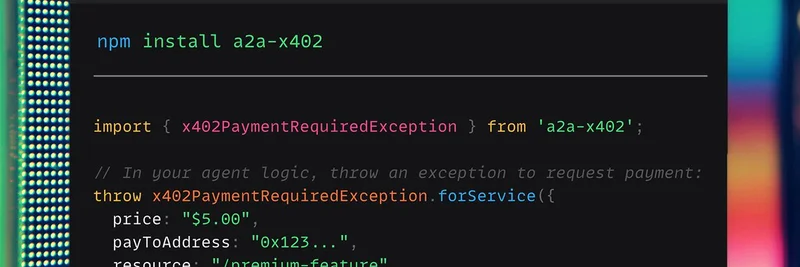Hey there, fellow blockchain tinkerers and AI enthusiasts. If you've been keeping an eye on the exploding world of agent-to-agent (A2A) interactions, you've probably heard the buzz around x402. It's not just another protocol—it's the key to letting AI agents handle crypto payments autonomously, without the usual clunky handshakes. And if you're like me, always hunting for ways to blend cutting-edge tech with practical builds, Nader Dabit's latest thread is pure gold.
In a crisp 7-minute video (yep, under 5 minutes of actual building time), Nader walks through creating custom x402 agents using his open-source TypeScript library. We're talking seamless requests for payments, verifications on-chain, and settlements that feel like magic. He even mods it to sell an eBook for just 1 USDC. Let's break it down, step by step, so you can jump in and experiment yourself.
What Even Is x402, Anyway?
Quick explainer: x402 is an extension to the HTTP protocol, cooked up by folks at Google as part of their Agentic Commerce push. Think of it like a polite interrupt button for web services—when an AI agent hits a paywall, it throws a special "402 Payment Required" exception. This triggers a crypto payment flow that's verifiable and secure, all while keeping things exception-based (no endless loops of back-and-forth).
It's built for A2A comms, meaning your AI buyer agent can haggle with a seller agent over Base Sepolia (or any EVM chain) without humans in the mix. Nader's ported the original Python library to TypeScript, making it a breeze for JS/TS devs to integrate. Install with npm install a2a-x402, and you're off to the races.
This isn't abstract theory—it's primed for real-world stuff like automated meme token trades or AI-driven NFT drops. Imagine agents scouting viral memes and settling micro-payments on the fly.
The 5-Minute Build: From Zero to Payment Flow
Nader starts simple: Clone the repo from GitHub. It ships with ready-to-run client and merchant agent examples, powered by Google's ADK (Agent Development Kit) in TypeScript.
Setup Envs: Copy the
.env.examplefiles into.envfor both client and merchant folders. Plug in your Google Gemini API key, private keys, and a Base Sepolia RPC URL. (Pro tip: Grab free Sepolia ETH and USDC from faucets to test without spending real gas.)Install & Run:
npm installin each folder, then fire upnpm run devfor the merchant server and client. Boom—your local agents are live on localhost:3000.Test the Basics: Chat with the client agent: "Buy a pencil." It pings the merchant, requests payment via x402, and settles 0.01 USDC on-chain. Head to Base Sepolia explorer to watch the ERC-20 transfer confirm in seconds.
Nader demos this live, showing the exception throw and catch in action. It's exception-based elegance: The client agent hits the paywall, pays up, and gets the green light.
Leveling Up: Selling an eBook with One Prompt
Here's where it gets fun—Nader skips the manual coding grind and uses "vibe coding" (his term for AI-assisted dev). He pastes a prompt into Cursor (an AI code editor powered by models like Claude or GPT) to refactor the merchant agent:
- Detect eBook interest in user queries.
- Request exactly 1 USDC.
- On payment confirm, serve a secure download link to a private PDF (he uses a sample devrel eBook).
The prompt? Something like: "Modify this merchant agent to sell 'Developer Relations Essentials' eBook for 1 USDC on Base Sepolia. Include payment verification and gated download." Hit run, let the AI handle the boilerplate, restart servers, and test.
Chat: "Tell me about your eBook." Agent: "It's $1 USDC—want it?" You: "Yes." Payment flows, link drops, done. Nader verifies the tx on-chain, proving it's not smoke and mirrors.
This vibe-coding hack? It's a game-changer for rapid prototyping. No more hours tweaking handlers—AI does the heavy lift, you focus on the cool parts.
Why This Matters for Blockchain Builders
x402 isn't niche; it's the plumbing for a future where AI agents run economies. Tie it to meme tokens? Easy—agents could auto-buy viral pumps or settle royalties for meme creators. With EigenLayer's AVS (Actively Validated Services) in the mix (shoutout to Nader's EigenCloud collabs), you get restaked security for these flows.
The ecosystem's heating up too. Check Joyce's x402 ecosystem map for players like Crossmint handling on-ramps. Or dive into the library explainer for deeper specs.
Get Building: Resources to Fork Right Now
- Codebase: a2a-x402-typescript on GitHub
- Vibe Coding Prompt: Gist for eBook mod
- Deploy Guide: To EigenCompute
- Full Ecosystem: From Crossmint
- AP2 Deep Dive: EigenCloud x Google Cloud
Grab the repo, tweak for your meme token marketplace idea, and share what you build. The agentic web is here—let's make it pay.
What’s your first x402 experiment? Drop it in the comments. 🚀

